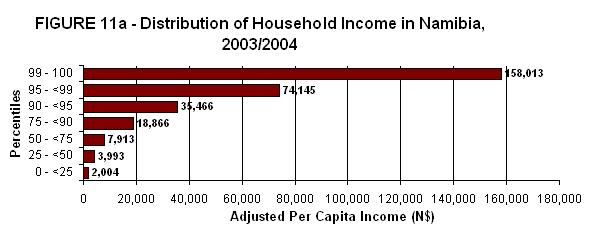Affordability
| Unit 11 |
Introduction | Legal Basis and Policy Issues | Determining Fee Levels | Deciding on a Fee Structure | Can Students Afford It? | Influence of Price on Demand | Providing for the Neediest Students |
Can Students Afford It?
The preceding discussion has, for the most part, taken no account of the financial position of learners (and their parents/relatives) or their ability to pay for education, both of which are extremely important considerations in setting fee levels.
The major parameter associated with the affordability of education relates to the disposable income available to the learner. While general statistics, such as Gross Domestic Product per capita, are generally available for many countries, such figures may mask considerable differences in the distribution of income.
For example, in the 2006 Human Development Report (page 285), the UNDP listed a relatively high GDP for Namibia at US$7,418 (approximately N$ 55,000) per capita. However, as can be seen in Figure 11a, income distribution in that country is highly skewed, a holdover from its colonial past. More than 95% of Namibians have annual incomes lower than the average figure reported by the UNDP. The wealthiest two percent of Namibians have an income almost forty times greater than the poorest half of the population.
Even where total household income appears adequate, much of it may be accounted for through consumption-in-kind of produce from subsistence agriculture. In many countries, periodic surveys of household income and expenditure are carried out by government bodies and these can provide more in-depth information on the disposable income available to students to pursue their education.
As discussed in the section above on Market-Related Fees, fees are not the only costs incurred by learners in pursuing their education. With the help of their families, they must find money for a variety of other expenses which, when taken together, exceed the amount paid as fees or contributions to school development funds. By eliminating the need for school uniforms, books and daily travel or boarding fees, ODL institutions can reduce the cost of education by a considerable amount. However, students may not appreciate the cost effectiveness of this approach if fees must be paid in full at the time of enrolment. By way of contrast, expenditure for those attending school can be spread more evenly throughout the year.
